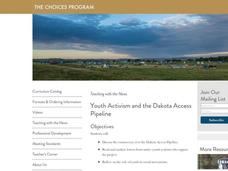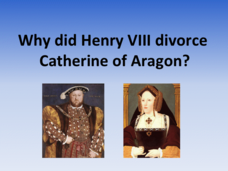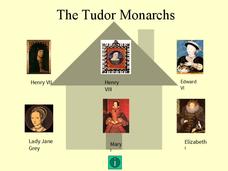Curated OER
The Sixties Protests and Social Change
Students identify, examine and analyze photographs of the sixties to determine the forces of social change at work in America during this decade. They determine the goals of each movement and the methods used by each to achieve those goals.
Curated OER
Rainforest People
In this geography worksheet, students read an excerpt about the rainforest people. Then, they respond to four short answer questions related to these people. Students explain what survival lessons the people learned from each other and...
Stanford University
Lesson Plan: The Children's Crusade and the Role of Youth in the African American Freedom Struggle
Young people played significant roles in the Civil Rights movement. Class members examine the contributions of Barbara Johns, Claudette Colvin, Mary Louise Smith, and the children of Birmingham,...
Atlanta History Center
Civil Disobedience and the Atlanta Student Movement
What tactics are used in civil disobedience? Learners study the conditions in Alabama that led to the establishment of the Atlanta Student Movement, as well as consider the nature and effectiveness of civil disobedience.
K12 Reader
Glossary of Non-Violence
Make sure your class is sure of terminology when referring to the non-violent methods used in the civil rights movement. This glossary includes 19 terms paired with parts of speech and definitions.
Read Works
Plymouth Colony
Read about the tumultuous beginning to the United States with an informational text passage about Colonial America. As young researchers peruse an article about the arrival of the Mayflower, the settlers' relationship to the neighboring...
Brown University
Youth Activism and the Dakota Access Pipeline
Do young people have a role in social movements? Should they? The involvement of young people in the Dakota Access Pipeline is the focus of a resource that asks class members to examine letters written by native youths who oppose the...
Curriculum Project
Gandhi
Introduce class members to Gandhi's non-violent, non-cooperative ideas with Richard Attenborough's 1982 bio-epic. The film traces the experiences that gave shape to Gandhi's ideas and the actions that eventually lead to the end of...
Curated OER
Applying Ahimsa to Traditional Stories
Investigate the life of Mahatma Gandhi by researching non-violent lifestyles. Learners define the word ahimsa and discuss the personal characteristics that made Gandhi a peaceful warrior. They also create a poster about the story "The...
Curated OER
Clash of Cultures and Marching North
Each of the 23 slides that comprise this presentation are intended to enhance or support lessons on shifts in religion and the colonization of the Americas. Students are guided through the changes in religion that ultimately lead to the...
Curated OER
Why Did King Henry VIII Divorce Catherine of Aragon?
Why did King Henry divorce Catherine of Aragon, and how did he make divorce possible? Young historians will read through each informational slide to learn the story of Catherine of Aragon, King Henry, and Anne Boleyn. They will then...
Curated OER
The Rule of Law
Students continue their exploration of the concept of rule of law. As a class, they discuss how Civil Rights leaders followed the rule of law in their protests. After reading various articles, they participate in a discussion and...
Curated OER
The Tudor Monarchs
A solid but basic overview of the Tudor Dynasty, this presentation provides details about Henry VIII and his successors. The slides would be a good addition to a session on the English monarchy, or within the context of a unit on the...
University of North Carolina
Sitting Down To Stand Up For Democracy
Boycotts and bus rides, sit-ins and speeches. The focus of this amazing resource is on those people who were willing to put themselves at risk to take a stand for their belief in equal rights for all. A must-have for your curriculum...
Curated OER
Selfless Service and The Giving Tree - Building Ethical Conscience
Upper elementary schoolers investigate philanthropy and selflessness by reading a children's book. For this ethics lesson, they read The Giving Tree by Shel Silverstein, and research Mahatma Gandhi's troublesome, yet inspiring, life....
PBS
Martin Luther King Jr.: Civil Rights Leader
Expand class members' appreciation of the work of Dr. Martin Luther King, Jr. A powerful resource examines King's speeches, writings, and actions that reveal his deep commitment to a nonviolent approach to Civil Rights. Learners watch a...
Echoes & Reflections
Jewish Resistance
Resistance to the Holocaust took on many forms. Learners explore the passive and active resistance of Jewish people who continued their practices and observances, as well as organized resistance against the evils of the Nazis. An...
Curated OER
Riot, Revolution and Reform
Students examine the student protests and subsequent massacre at Tiananmen Square in 1989 and the current petition by victims' family members to open a criminal investigation of the responsible officials.
Curated OER
And Then One Night, The Making of Dead Man Walking: Classroom Content
Students examine how art and music help to define and unify a social movement and also how they can function as symbols of protest. They watch KQED program And Then One Night: The Making of Dead Man Walking and discuss what happens when...
Curated OER
Whose Fate at the G-8?
Students explore the 2005 Group of 8 Summit, investigating the member countries' views on the summit issues, as well as the views of the African Union and G-8 protesters. They offer predictions on outcomes of the summit given this...
Curated OER
The Whole World is Watching: Iran, 2009
Students study the impact of social media. In this Iranian election lesson plan, students examine the outcome of the 2009 election and the public protests that followed it. Students determine how citizen journalism informed people around...
Curated OER
Language Arts, Social Studies, African Americans, The Blues, To Kill A Mockingbird
African American history during the Jim Crow era includes encounters with poverty, racism, disrespect, and protest. Harper Lee develops all four of these themes in her famous 1960 novel, To Kill a Mockingbird. To help students understand...
Curated OER
A Picture Is Worth a Thousand Words
Seventh graders create a multimedia, image only ad campaign on a contemporary controversial issue. They base their public service announcement, Powerpoint presentation, Web page, or video on methods used by Martin Luther during the...
Curated OER
NYC Muslim Community Center: Why there? Why not?
High schoolers examine religious diversity issues. In this current events lesson, students read the provided articles "Sacred Ground or Bridging a Cultural Divide?" "Multiple Views of the Proposed Muslim Center," and "Protests, a...
Other popular searches
- Student Protests
- Vietnam War Protests
- Nonviolence Protests
- Protests in the 1960's
- Anti War Protests
- Anti American Protests
- Tiananmen Square Protests
- Vietnam Protests
- Counterculture Protests
- Nonviolent Protests
- Student Protests 60's
- Tienanmen Square Protests

























